Strategies to Improve Employee Motivation Post-Pandemic in UK (7IM996)
VerifiedAdded on 2023/06/10
|59
|21288
|333
Report
AI Summary
This report investigates strategies to improve employee motivation in the UK, particularly in the context of the post-COVID-19 pandemic. It begins by defining motivation and its importance for organizational success, distinguishing between internal and external motivators. The research focuses on Marks and Spencer as a case study, examining the impact of the pandemic on employee motivation and the strategies employed to address it. The objectives include understanding motivation theories, identifying M&S's strategies, and assessing the benefits of enhanced employee motivation. The report includes a literature review, research methodology, data analysis, and discussion, concluding with recommendations for fostering a motivated workforce. The study highlights the significance of employee motivation for achieving business goals, creating a positive work environment, and maintaining a competitive advantage, especially in the challenging environment following the pandemic.
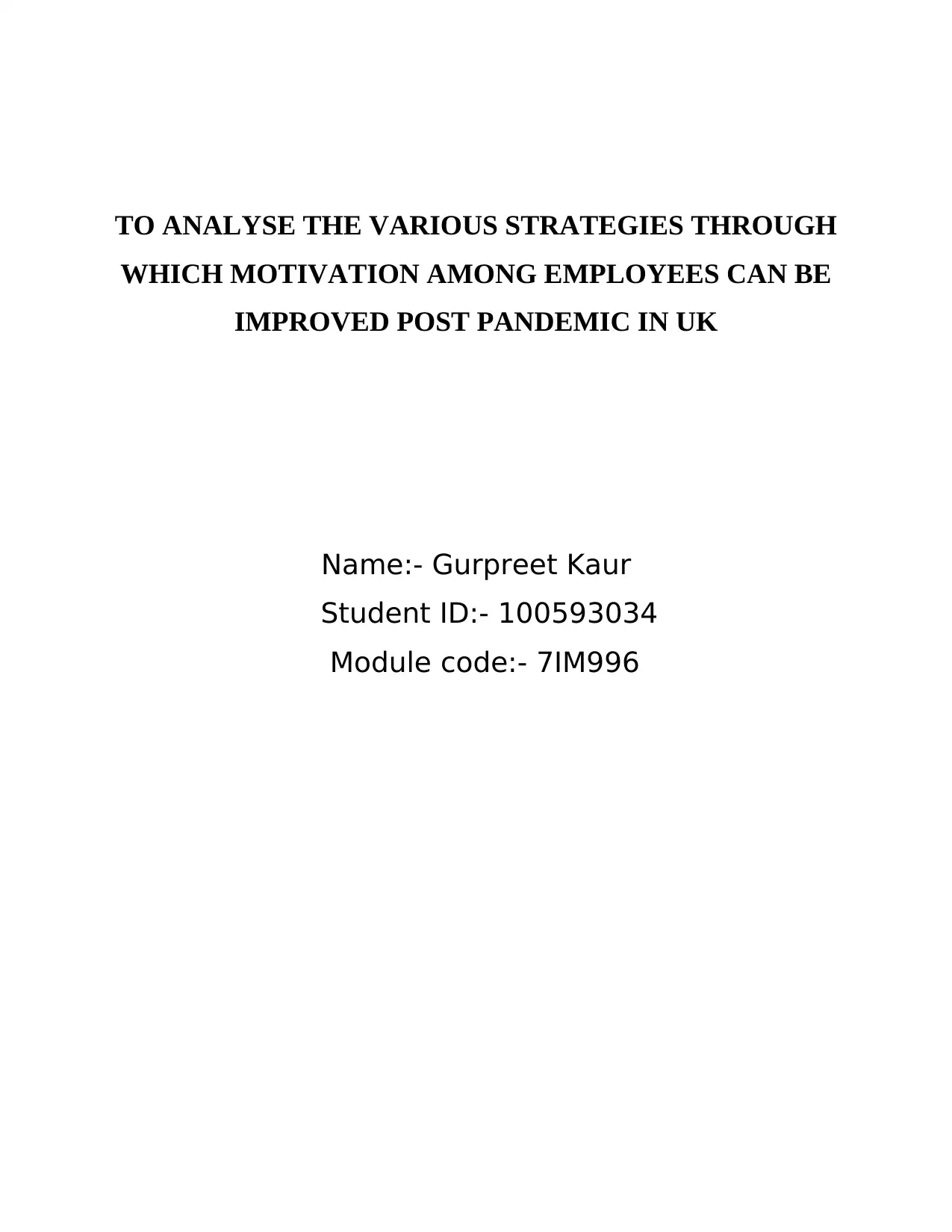
TO ANALYSE THE VARIOUS STRATEGIES THROUGH
WHICH MOTIVATION AMONG EMPLOYEES CAN BE
IMPROVED POST PANDEMIC IN UK
Name:- Gurpreet Kaur
Student ID:- 100593034
Module code:- 7IM996
WHICH MOTIVATION AMONG EMPLOYEES CAN BE
IMPROVED POST PANDEMIC IN UK
Name:- Gurpreet Kaur
Student ID:- 100593034
Module code:- 7IM996
Paraphrase This Document
Need a fresh take? Get an instant paraphrase of this document with our AI Paraphraser
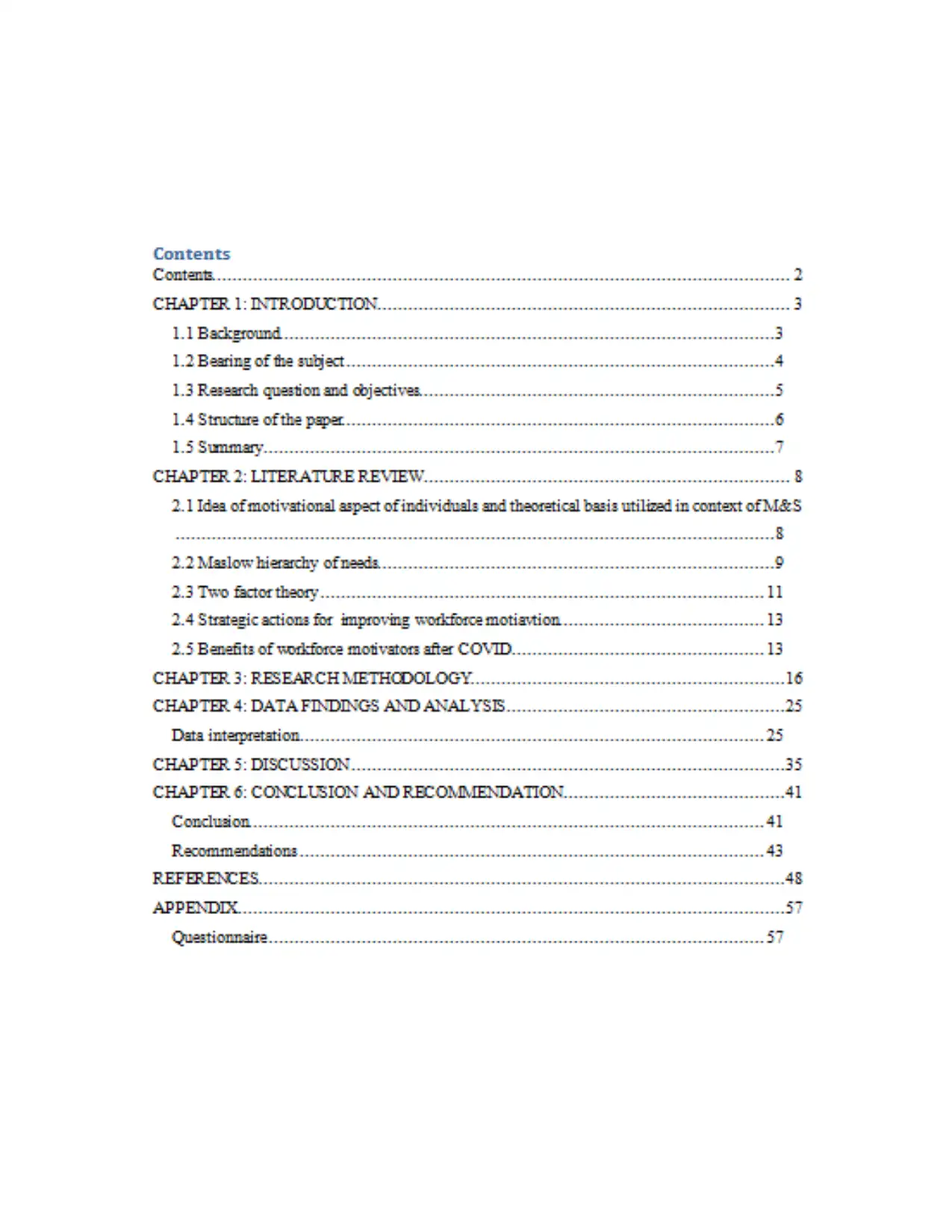
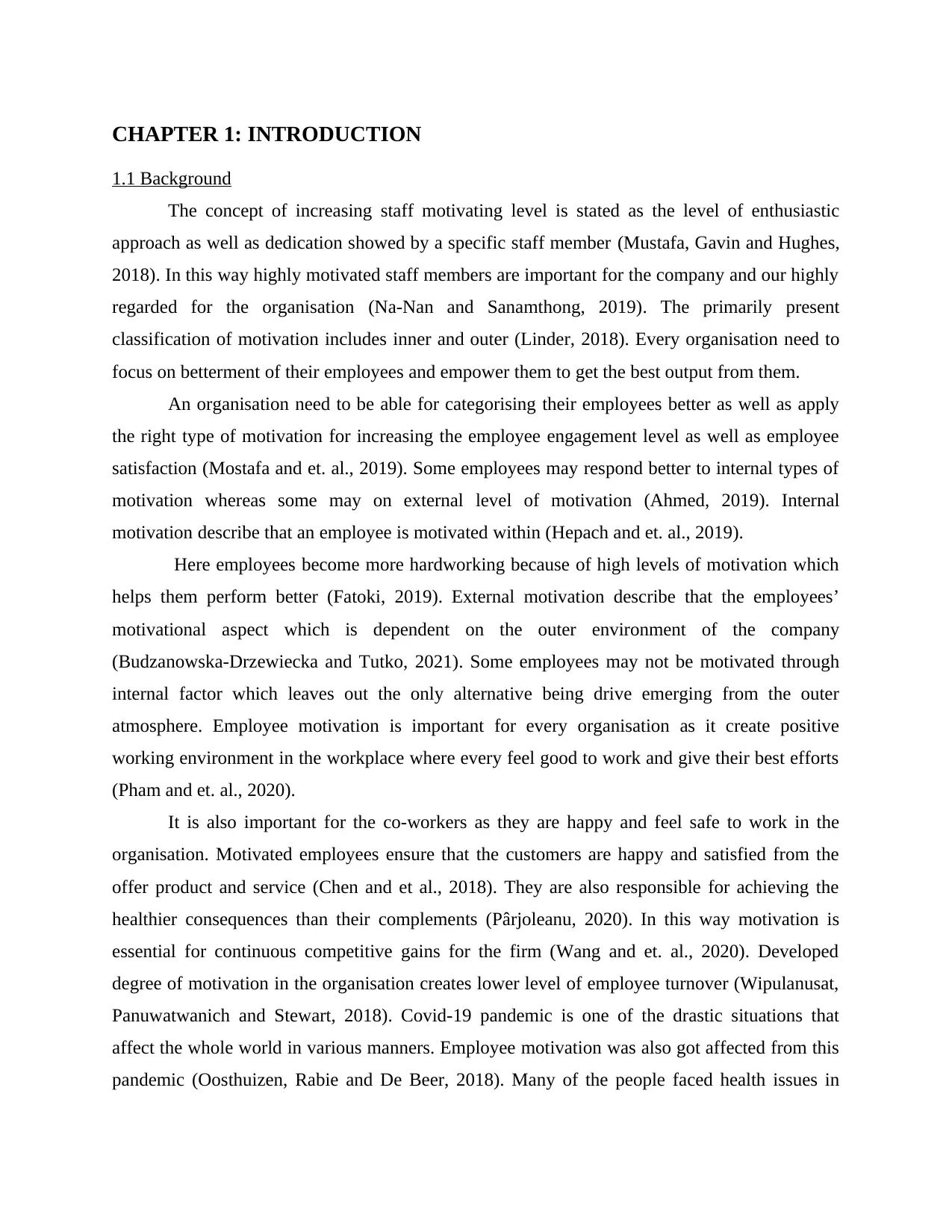
CHAPTER 1: INTRODUCTION
1.1 Background
The concept of increasing staff motivating level is stated as the level of enthusiastic
approach as well as dedication showed by a specific staff member (Mustafa, Gavin and Hughes,
2018). In this way highly motivated staff members are important for the company and our highly
regarded for the organisation (Na-Nan and Sanamthong, 2019). The primarily present
classification of motivation includes inner and outer (Linder, 2018). Every organisation need to
focus on betterment of their employees and empower them to get the best output from them.
An organisation need to be able for categorising their employees better as well as apply
the right type of motivation for increasing the employee engagement level as well as employee
satisfaction (Mostafa and et. al., 2019). Some employees may respond better to internal types of
motivation whereas some may on external level of motivation (Ahmed, 2019). Internal
motivation describe that an employee is motivated within (Hepach and et. al., 2019).
Here employees become more hardworking because of high levels of motivation which
helps them perform better (Fatoki, 2019). External motivation describe that the employees’
motivational aspect which is dependent on the outer environment of the company
(Budzanowska-Drzewiecka and Tutko, 2021). Some employees may not be motivated through
internal factor which leaves out the only alternative being drive emerging from the outer
atmosphere. Employee motivation is important for every organisation as it create positive
working environment in the workplace where every feel good to work and give their best efforts
(Pham and et. al., 2020).
It is also important for the co-workers as they are happy and feel safe to work in the
organisation. Motivated employees ensure that the customers are happy and satisfied from the
offer product and service (Chen and et al., 2018). They are also responsible for achieving the
healthier consequences than their complements (Pârjoleanu, 2020). In this way motivation is
essential for continuous competitive gains for the firm (Wang and et. al., 2020). Developed
degree of motivation in the organisation creates lower level of employee turnover (Wipulanusat,
Panuwatwanich and Stewart, 2018). Covid-19 pandemic is one of the drastic situations that
affect the whole world in various manners. Employee motivation was also got affected from this
pandemic (Oosthuizen, Rabie and De Beer, 2018). Many of the people faced health issues in
1.1 Background
The concept of increasing staff motivating level is stated as the level of enthusiastic
approach as well as dedication showed by a specific staff member (Mustafa, Gavin and Hughes,
2018). In this way highly motivated staff members are important for the company and our highly
regarded for the organisation (Na-Nan and Sanamthong, 2019). The primarily present
classification of motivation includes inner and outer (Linder, 2018). Every organisation need to
focus on betterment of their employees and empower them to get the best output from them.
An organisation need to be able for categorising their employees better as well as apply
the right type of motivation for increasing the employee engagement level as well as employee
satisfaction (Mostafa and et. al., 2019). Some employees may respond better to internal types of
motivation whereas some may on external level of motivation (Ahmed, 2019). Internal
motivation describe that an employee is motivated within (Hepach and et. al., 2019).
Here employees become more hardworking because of high levels of motivation which
helps them perform better (Fatoki, 2019). External motivation describe that the employees’
motivational aspect which is dependent on the outer environment of the company
(Budzanowska-Drzewiecka and Tutko, 2021). Some employees may not be motivated through
internal factor which leaves out the only alternative being drive emerging from the outer
atmosphere. Employee motivation is important for every organisation as it create positive
working environment in the workplace where every feel good to work and give their best efforts
(Pham and et. al., 2020).
It is also important for the co-workers as they are happy and feel safe to work in the
organisation. Motivated employees ensure that the customers are happy and satisfied from the
offer product and service (Chen and et al., 2018). They are also responsible for achieving the
healthier consequences than their complements (Pârjoleanu, 2020). In this way motivation is
essential for continuous competitive gains for the firm (Wang and et. al., 2020). Developed
degree of motivation in the organisation creates lower level of employee turnover (Wipulanusat,
Panuwatwanich and Stewart, 2018). Covid-19 pandemic is one of the drastic situations that
affect the whole world in various manners. Employee motivation was also got affected from this
pandemic (Oosthuizen, Rabie and De Beer, 2018). Many of the people faced health issues in
⊘ This is a preview!⊘
Do you want full access?
Subscribe today to unlock all pages.

Trusted by 1+ million students worldwide
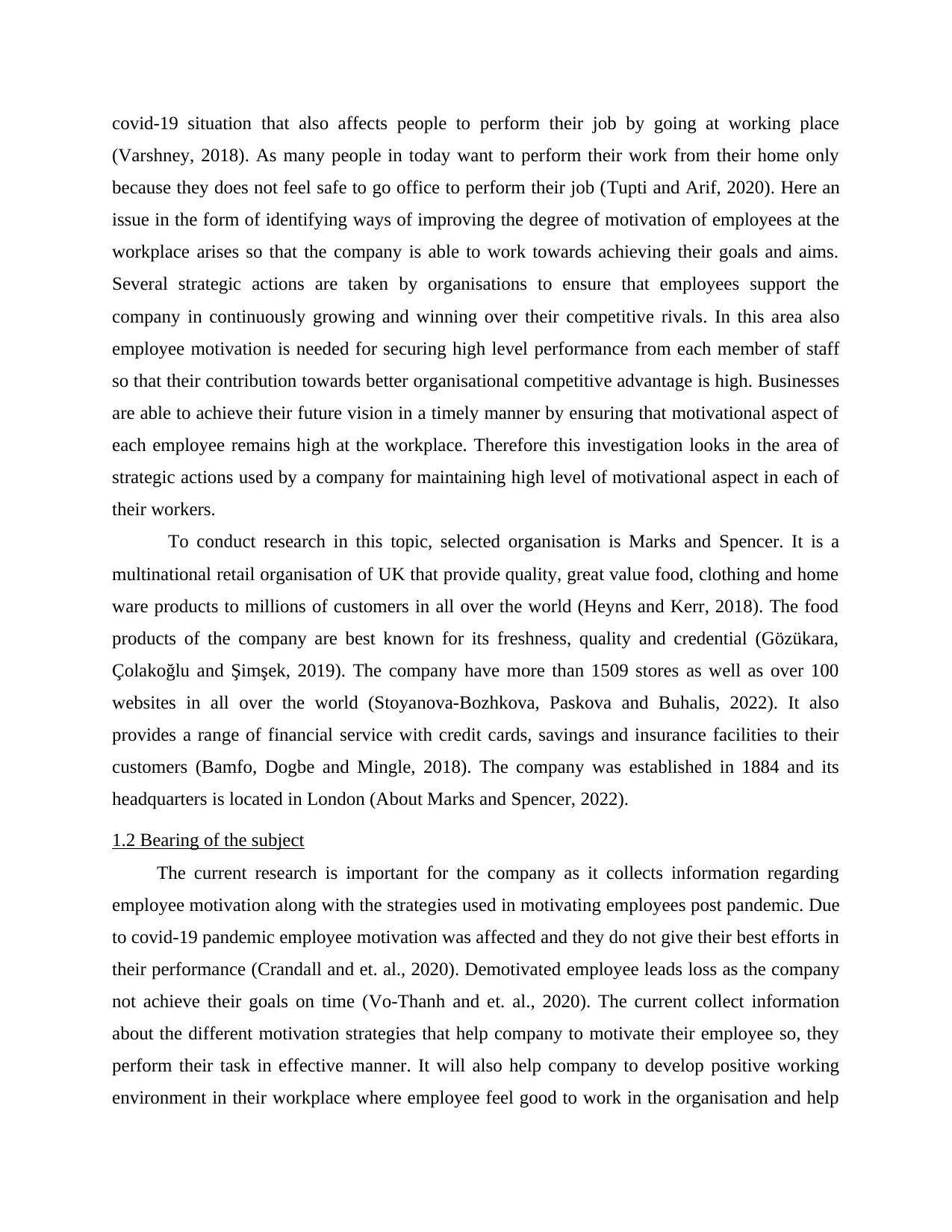
covid-19 situation that also affects people to perform their job by going at working place
(Varshney, 2018). As many people in today want to perform their work from their home only
because they does not feel safe to go office to perform their job (Tupti and Arif, 2020). Here an
issue in the form of identifying ways of improving the degree of motivation of employees at the
workplace arises so that the company is able to work towards achieving their goals and aims.
Several strategic actions are taken by organisations to ensure that employees support the
company in continuously growing and winning over their competitive rivals. In this area also
employee motivation is needed for securing high level performance from each member of staff
so that their contribution towards better organisational competitive advantage is high. Businesses
are able to achieve their future vision in a timely manner by ensuring that motivational aspect of
each employee remains high at the workplace. Therefore this investigation looks in the area of
strategic actions used by a company for maintaining high level of motivational aspect in each of
their workers.
To conduct research in this topic, selected organisation is Marks and Spencer. It is a
multinational retail organisation of UK that provide quality, great value food, clothing and home
ware products to millions of customers in all over the world (Heyns and Kerr, 2018). The food
products of the company are best known for its freshness, quality and credential (Gözükara,
Çolakoğlu and Şimşek, 2019). The company have more than 1509 stores as well as over 100
websites in all over the world (Stoyanova-Bozhkova, Paskova and Buhalis, 2022). It also
provides a range of financial service with credit cards, savings and insurance facilities to their
customers (Bamfo, Dogbe and Mingle, 2018). The company was established in 1884 and its
headquarters is located in London (About Marks and Spencer, 2022).
1.2 Bearing of the subject
The current research is important for the company as it collects information regarding
employee motivation along with the strategies used in motivating employees post pandemic. Due
to covid-19 pandemic employee motivation was affected and they do not give their best efforts in
their performance (Crandall and et. al., 2020). Demotivated employee leads loss as the company
not achieve their goals on time (Vo-Thanh and et. al., 2020). The current collect information
about the different motivation strategies that help company to motivate their employee so, they
perform their task in effective manner. It will also help company to develop positive working
environment in their workplace where employee feel good to work in the organisation and help
(Varshney, 2018). As many people in today want to perform their work from their home only
because they does not feel safe to go office to perform their job (Tupti and Arif, 2020). Here an
issue in the form of identifying ways of improving the degree of motivation of employees at the
workplace arises so that the company is able to work towards achieving their goals and aims.
Several strategic actions are taken by organisations to ensure that employees support the
company in continuously growing and winning over their competitive rivals. In this area also
employee motivation is needed for securing high level performance from each member of staff
so that their contribution towards better organisational competitive advantage is high. Businesses
are able to achieve their future vision in a timely manner by ensuring that motivational aspect of
each employee remains high at the workplace. Therefore this investigation looks in the area of
strategic actions used by a company for maintaining high level of motivational aspect in each of
their workers.
To conduct research in this topic, selected organisation is Marks and Spencer. It is a
multinational retail organisation of UK that provide quality, great value food, clothing and home
ware products to millions of customers in all over the world (Heyns and Kerr, 2018). The food
products of the company are best known for its freshness, quality and credential (Gözükara,
Çolakoğlu and Şimşek, 2019). The company have more than 1509 stores as well as over 100
websites in all over the world (Stoyanova-Bozhkova, Paskova and Buhalis, 2022). It also
provides a range of financial service with credit cards, savings and insurance facilities to their
customers (Bamfo, Dogbe and Mingle, 2018). The company was established in 1884 and its
headquarters is located in London (About Marks and Spencer, 2022).
1.2 Bearing of the subject
The current research is important for the company as it collects information regarding
employee motivation along with the strategies used in motivating employees post pandemic. Due
to covid-19 pandemic employee motivation was affected and they do not give their best efforts in
their performance (Crandall and et. al., 2020). Demotivated employee leads loss as the company
not achieve their goals on time (Vo-Thanh and et. al., 2020). The current collect information
about the different motivation strategies that help company to motivate their employee so, they
perform their task in effective manner. It will also help company to develop positive working
environment in their workplace where employee feel good to work in the organisation and help
Paraphrase This Document
Need a fresh take? Get an instant paraphrase of this document with our AI Paraphraser
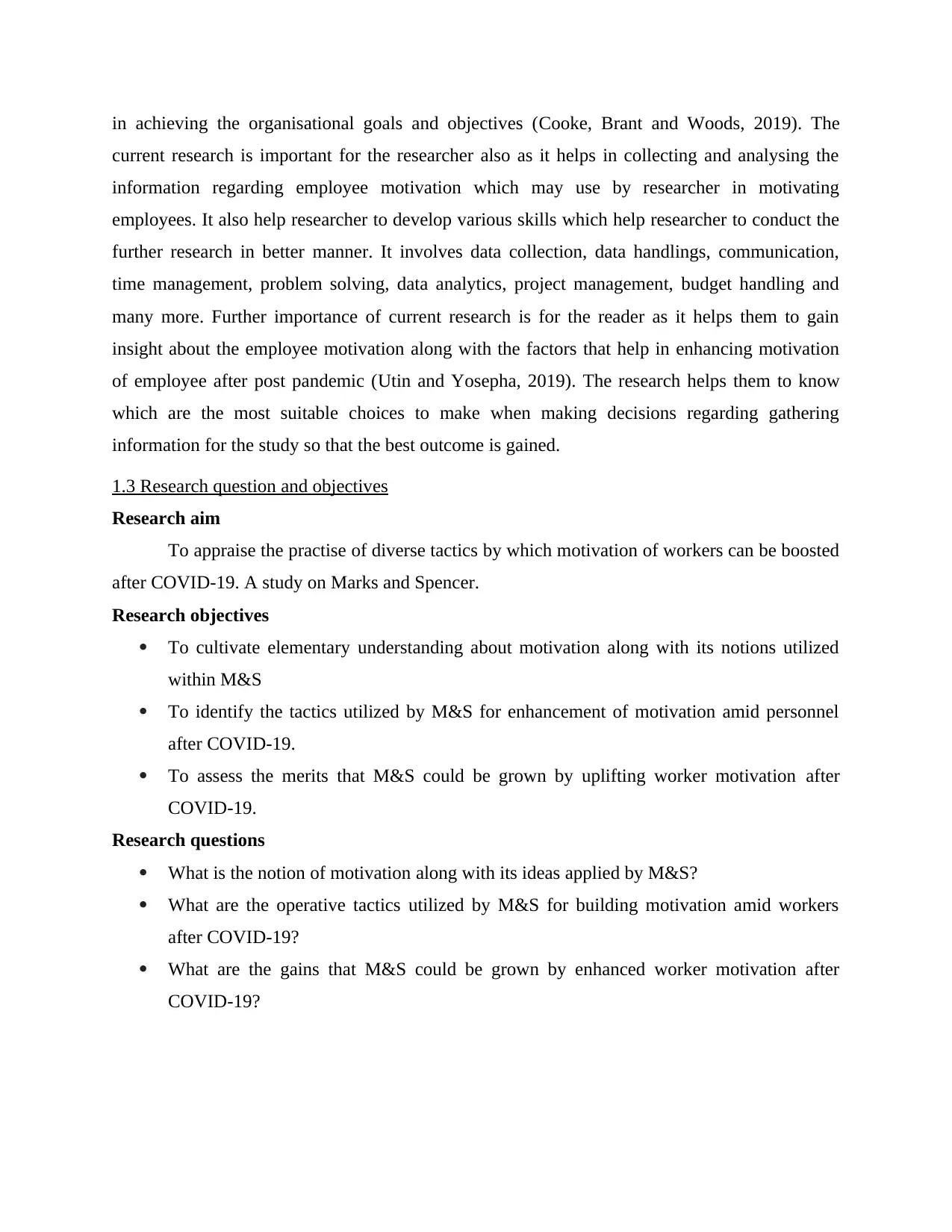
in achieving the organisational goals and objectives (Cooke, Brant and Woods, 2019). The
current research is important for the researcher also as it helps in collecting and analysing the
information regarding employee motivation which may use by researcher in motivating
employees. It also help researcher to develop various skills which help researcher to conduct the
further research in better manner. It involves data collection, data handlings, communication,
time management, problem solving, data analytics, project management, budget handling and
many more. Further importance of current research is for the reader as it helps them to gain
insight about the employee motivation along with the factors that help in enhancing motivation
of employee after post pandemic (Utin and Yosepha, 2019). The research helps them to know
which are the most suitable choices to make when making decisions regarding gathering
information for the study so that the best outcome is gained.
1.3 Research question and objectives
Research aim
To appraise the practise of diverse tactics by which motivation of workers can be boosted
after COVID-19. A study on Marks and Spencer.
Research objectives
To cultivate elementary understanding about motivation along with its notions utilized
within M&S
To identify the tactics utilized by M&S for enhancement of motivation amid personnel
after COVID-19.
To assess the merits that M&S could be grown by uplifting worker motivation after
COVID-19.
Research questions
What is the notion of motivation along with its ideas applied by M&S?
What are the operative tactics utilized by M&S for building motivation amid workers
after COVID-19?
What are the gains that M&S could be grown by enhanced worker motivation after
COVID-19?
current research is important for the researcher also as it helps in collecting and analysing the
information regarding employee motivation which may use by researcher in motivating
employees. It also help researcher to develop various skills which help researcher to conduct the
further research in better manner. It involves data collection, data handlings, communication,
time management, problem solving, data analytics, project management, budget handling and
many more. Further importance of current research is for the reader as it helps them to gain
insight about the employee motivation along with the factors that help in enhancing motivation
of employee after post pandemic (Utin and Yosepha, 2019). The research helps them to know
which are the most suitable choices to make when making decisions regarding gathering
information for the study so that the best outcome is gained.
1.3 Research question and objectives
Research aim
To appraise the practise of diverse tactics by which motivation of workers can be boosted
after COVID-19. A study on Marks and Spencer.
Research objectives
To cultivate elementary understanding about motivation along with its notions utilized
within M&S
To identify the tactics utilized by M&S for enhancement of motivation amid personnel
after COVID-19.
To assess the merits that M&S could be grown by uplifting worker motivation after
COVID-19.
Research questions
What is the notion of motivation along with its ideas applied by M&S?
What are the operative tactics utilized by M&S for building motivation amid workers
after COVID-19?
What are the gains that M&S could be grown by enhanced worker motivation after
COVID-19?
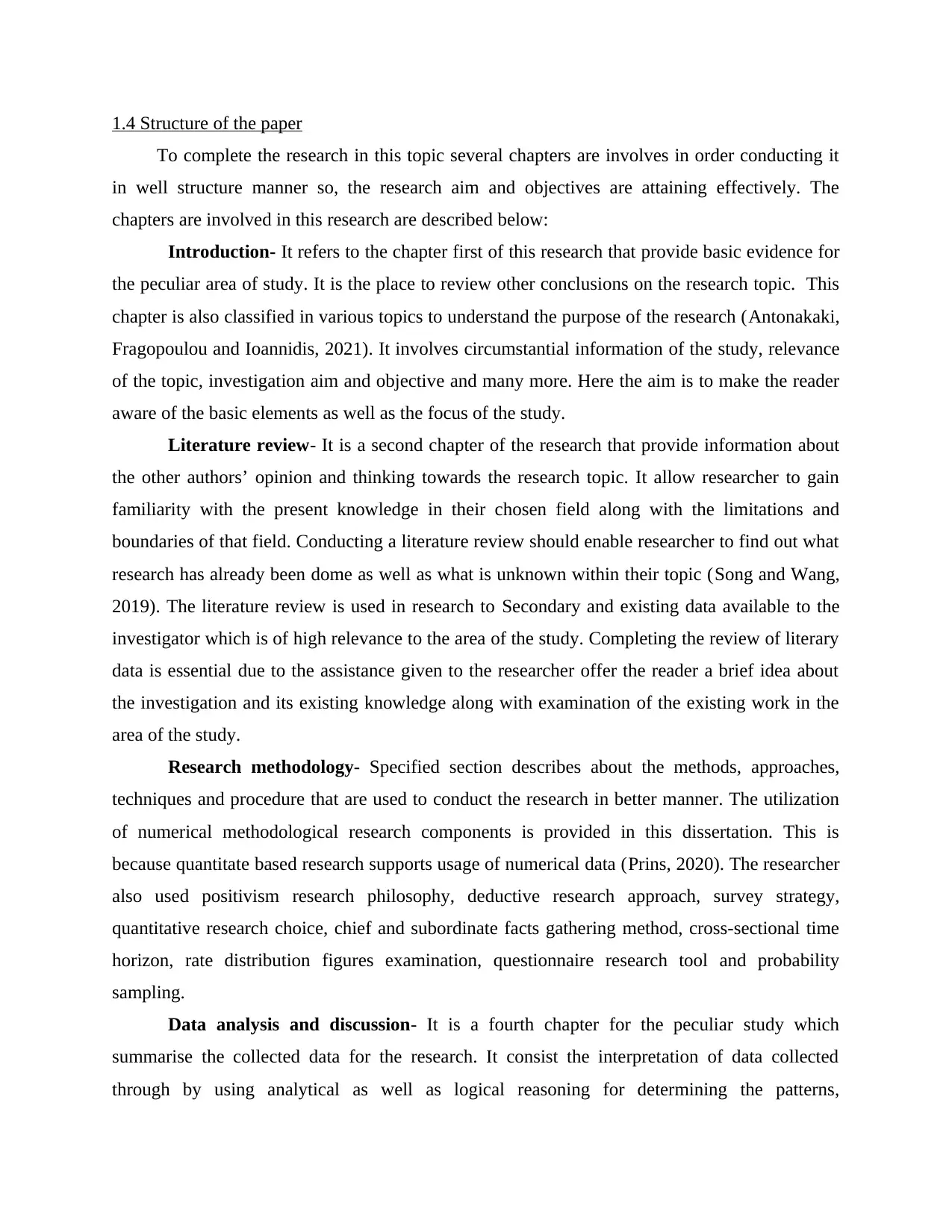
1.4 Structure of the paper
To complete the research in this topic several chapters are involves in order conducting it
in well structure manner so, the research aim and objectives are attaining effectively. The
chapters are involved in this research are described below:
Introduction- It refers to the chapter first of this research that provide basic evidence for
the peculiar area of study. It is the place to review other conclusions on the research topic. This
chapter is also classified in various topics to understand the purpose of the research (Antonakaki,
Fragopoulou and Ioannidis, 2021). It involves circumstantial information of the study, relevance
of the topic, investigation aim and objective and many more. Here the aim is to make the reader
aware of the basic elements as well as the focus of the study.
Literature review- It is a second chapter of the research that provide information about
the other authors’ opinion and thinking towards the research topic. It allow researcher to gain
familiarity with the present knowledge in their chosen field along with the limitations and
boundaries of that field. Conducting a literature review should enable researcher to find out what
research has already been dome as well as what is unknown within their topic (Song and Wang,
2019). The literature review is used in research to Secondary and existing data available to the
investigator which is of high relevance to the area of the study. Completing the review of literary
data is essential due to the assistance given to the researcher offer the reader a brief idea about
the investigation and its existing knowledge along with examination of the existing work in the
area of the study.
Research methodology- Specified section describes about the methods, approaches,
techniques and procedure that are used to conduct the research in better manner. The utilization
of numerical methodological research components is provided in this dissertation. This is
because quantitate based research supports usage of numerical data (Prins, 2020). The researcher
also used positivism research philosophy, deductive research approach, survey strategy,
quantitative research choice, chief and subordinate facts gathering method, cross-sectional time
horizon, rate distribution figures examination, questionnaire research tool and probability
sampling.
Data analysis and discussion- It is a fourth chapter for the peculiar study which
summarise the collected data for the research. It consist the interpretation of data collected
through by using analytical as well as logical reasoning for determining the patterns,
To complete the research in this topic several chapters are involves in order conducting it
in well structure manner so, the research aim and objectives are attaining effectively. The
chapters are involved in this research are described below:
Introduction- It refers to the chapter first of this research that provide basic evidence for
the peculiar area of study. It is the place to review other conclusions on the research topic. This
chapter is also classified in various topics to understand the purpose of the research (Antonakaki,
Fragopoulou and Ioannidis, 2021). It involves circumstantial information of the study, relevance
of the topic, investigation aim and objective and many more. Here the aim is to make the reader
aware of the basic elements as well as the focus of the study.
Literature review- It is a second chapter of the research that provide information about
the other authors’ opinion and thinking towards the research topic. It allow researcher to gain
familiarity with the present knowledge in their chosen field along with the limitations and
boundaries of that field. Conducting a literature review should enable researcher to find out what
research has already been dome as well as what is unknown within their topic (Song and Wang,
2019). The literature review is used in research to Secondary and existing data available to the
investigator which is of high relevance to the area of the study. Completing the review of literary
data is essential due to the assistance given to the researcher offer the reader a brief idea about
the investigation and its existing knowledge along with examination of the existing work in the
area of the study.
Research methodology- Specified section describes about the methods, approaches,
techniques and procedure that are used to conduct the research in better manner. The utilization
of numerical methodological research components is provided in this dissertation. This is
because quantitate based research supports usage of numerical data (Prins, 2020). The researcher
also used positivism research philosophy, deductive research approach, survey strategy,
quantitative research choice, chief and subordinate facts gathering method, cross-sectional time
horizon, rate distribution figures examination, questionnaire research tool and probability
sampling.
Data analysis and discussion- It is a fourth chapter for the peculiar study which
summarise the collected data for the research. It consist the interpretation of data collected
through by using analytical as well as logical reasoning for determining the patterns,
⊘ This is a preview!⊘
Do you want full access?
Subscribe today to unlock all pages.

Trusted by 1+ million students worldwide
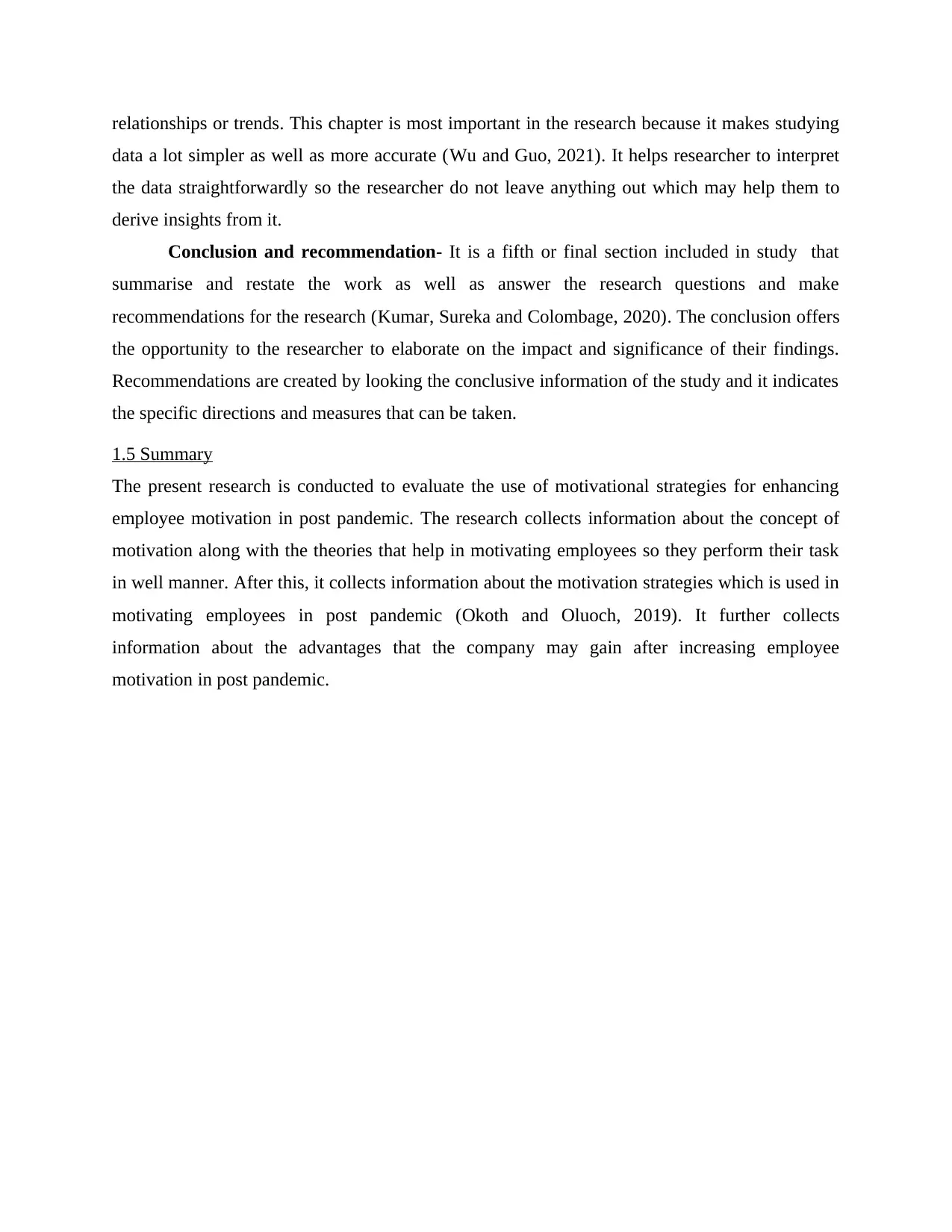
relationships or trends. This chapter is most important in the research because it makes studying
data a lot simpler as well as more accurate (Wu and Guo, 2021). It helps researcher to interpret
the data straightforwardly so the researcher do not leave anything out which may help them to
derive insights from it.
Conclusion and recommendation- It is a fifth or final section included in study that
summarise and restate the work as well as answer the research questions and make
recommendations for the research (Kumar, Sureka and Colombage, 2020). The conclusion offers
the opportunity to the researcher to elaborate on the impact and significance of their findings.
Recommendations are created by looking the conclusive information of the study and it indicates
the specific directions and measures that can be taken.
1.5 Summary
The present research is conducted to evaluate the use of motivational strategies for enhancing
employee motivation in post pandemic. The research collects information about the concept of
motivation along with the theories that help in motivating employees so they perform their task
in well manner. After this, it collects information about the motivation strategies which is used in
motivating employees in post pandemic (Okoth and Oluoch, 2019). It further collects
information about the advantages that the company may gain after increasing employee
motivation in post pandemic.
data a lot simpler as well as more accurate (Wu and Guo, 2021). It helps researcher to interpret
the data straightforwardly so the researcher do not leave anything out which may help them to
derive insights from it.
Conclusion and recommendation- It is a fifth or final section included in study that
summarise and restate the work as well as answer the research questions and make
recommendations for the research (Kumar, Sureka and Colombage, 2020). The conclusion offers
the opportunity to the researcher to elaborate on the impact and significance of their findings.
Recommendations are created by looking the conclusive information of the study and it indicates
the specific directions and measures that can be taken.
1.5 Summary
The present research is conducted to evaluate the use of motivational strategies for enhancing
employee motivation in post pandemic. The research collects information about the concept of
motivation along with the theories that help in motivating employees so they perform their task
in well manner. After this, it collects information about the motivation strategies which is used in
motivating employees in post pandemic (Okoth and Oluoch, 2019). It further collects
information about the advantages that the company may gain after increasing employee
motivation in post pandemic.
Paraphrase This Document
Need a fresh take? Get an instant paraphrase of this document with our AI Paraphraser
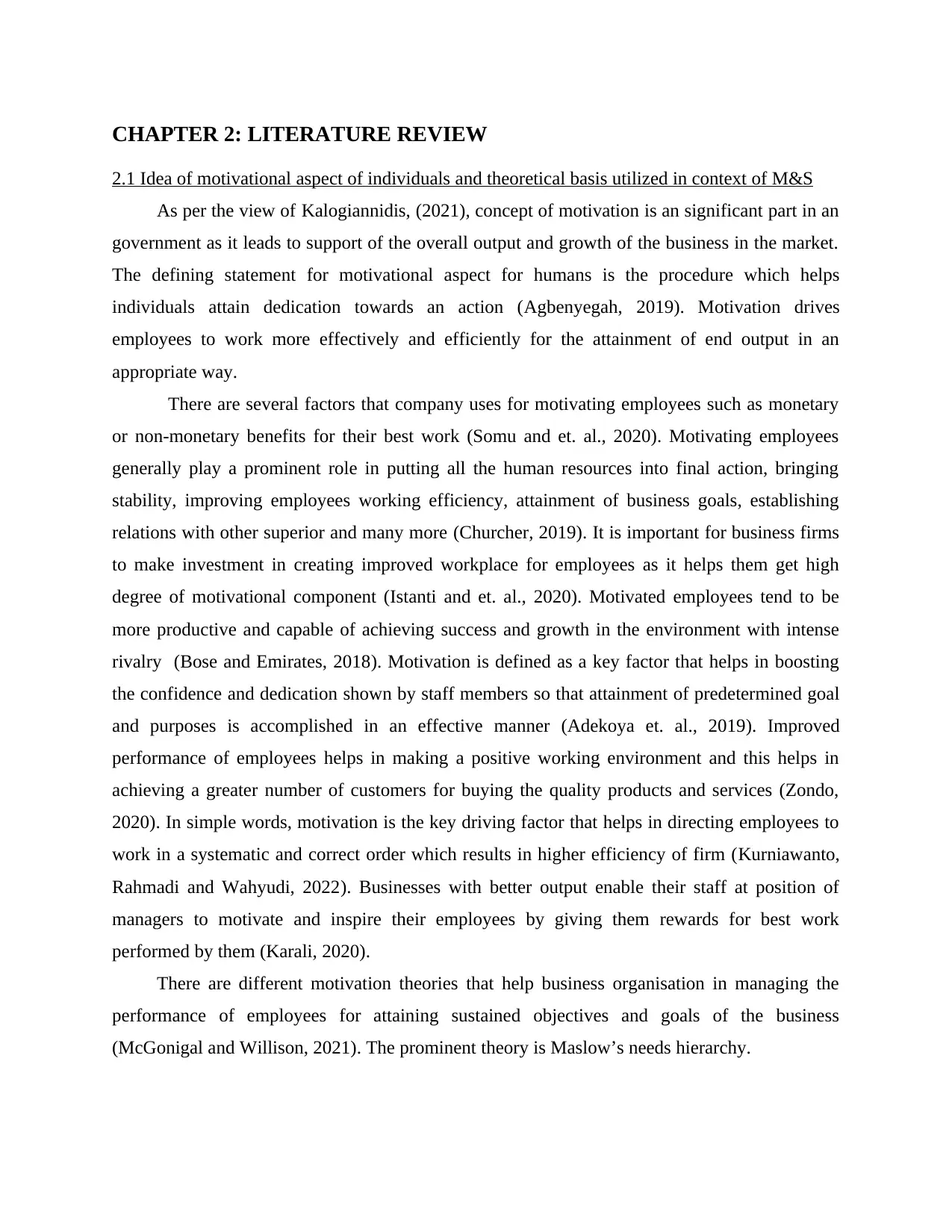
CHAPTER 2: LITERATURE REVIEW
2.1 Idea of motivational aspect of individuals and theoretical basis utilized in context of M&S
As per the view of Kalogiannidis, (2021), concept of motivation is an significant part in an
government as it leads to support of the overall output and growth of the business in the market.
The defining statement for motivational aspect for humans is the procedure which helps
individuals attain dedication towards an action (Agbenyegah, 2019). Motivation drives
employees to work more effectively and efficiently for the attainment of end output in an
appropriate way.
There are several factors that company uses for motivating employees such as monetary
or non-monetary benefits for their best work (Somu and et. al., 2020). Motivating employees
generally play a prominent role in putting all the human resources into final action, bringing
stability, improving employees working efficiency, attainment of business goals, establishing
relations with other superior and many more (Churcher, 2019). It is important for business firms
to make investment in creating improved workplace for employees as it helps them get high
degree of motivational component (Istanti and et. al., 2020). Motivated employees tend to be
more productive and capable of achieving success and growth in the environment with intense
rivalry (Bose and Emirates, 2018). Motivation is defined as a key factor that helps in boosting
the confidence and dedication shown by staff members so that attainment of predetermined goal
and purposes is accomplished in an effective manner (Adekoya et. al., 2019). Improved
performance of employees helps in making a positive working environment and this helps in
achieving a greater number of customers for buying the quality products and services (Zondo,
2020). In simple words, motivation is the key driving factor that helps in directing employees to
work in a systematic and correct order which results in higher efficiency of firm (Kurniawanto,
Rahmadi and Wahyudi, 2022). Businesses with better output enable their staff at position of
managers to motivate and inspire their employees by giving them rewards for best work
performed by them (Karali, 2020).
There are different motivation theories that help business organisation in managing the
performance of employees for attaining sustained objectives and goals of the business
(McGonigal and Willison, 2021). The prominent theory is Maslow’s needs hierarchy.
2.1 Idea of motivational aspect of individuals and theoretical basis utilized in context of M&S
As per the view of Kalogiannidis, (2021), concept of motivation is an significant part in an
government as it leads to support of the overall output and growth of the business in the market.
The defining statement for motivational aspect for humans is the procedure which helps
individuals attain dedication towards an action (Agbenyegah, 2019). Motivation drives
employees to work more effectively and efficiently for the attainment of end output in an
appropriate way.
There are several factors that company uses for motivating employees such as monetary
or non-monetary benefits for their best work (Somu and et. al., 2020). Motivating employees
generally play a prominent role in putting all the human resources into final action, bringing
stability, improving employees working efficiency, attainment of business goals, establishing
relations with other superior and many more (Churcher, 2019). It is important for business firms
to make investment in creating improved workplace for employees as it helps them get high
degree of motivational component (Istanti and et. al., 2020). Motivated employees tend to be
more productive and capable of achieving success and growth in the environment with intense
rivalry (Bose and Emirates, 2018). Motivation is defined as a key factor that helps in boosting
the confidence and dedication shown by staff members so that attainment of predetermined goal
and purposes is accomplished in an effective manner (Adekoya et. al., 2019). Improved
performance of employees helps in making a positive working environment and this helps in
achieving a greater number of customers for buying the quality products and services (Zondo,
2020). In simple words, motivation is the key driving factor that helps in directing employees to
work in a systematic and correct order which results in higher efficiency of firm (Kurniawanto,
Rahmadi and Wahyudi, 2022). Businesses with better output enable their staff at position of
managers to motivate and inspire their employees by giving them rewards for best work
performed by them (Karali, 2020).
There are different motivation theories that help business organisation in managing the
performance of employees for attaining sustained objectives and goals of the business
(McGonigal and Willison, 2021). The prominent theory is Maslow’s needs hierarchy.
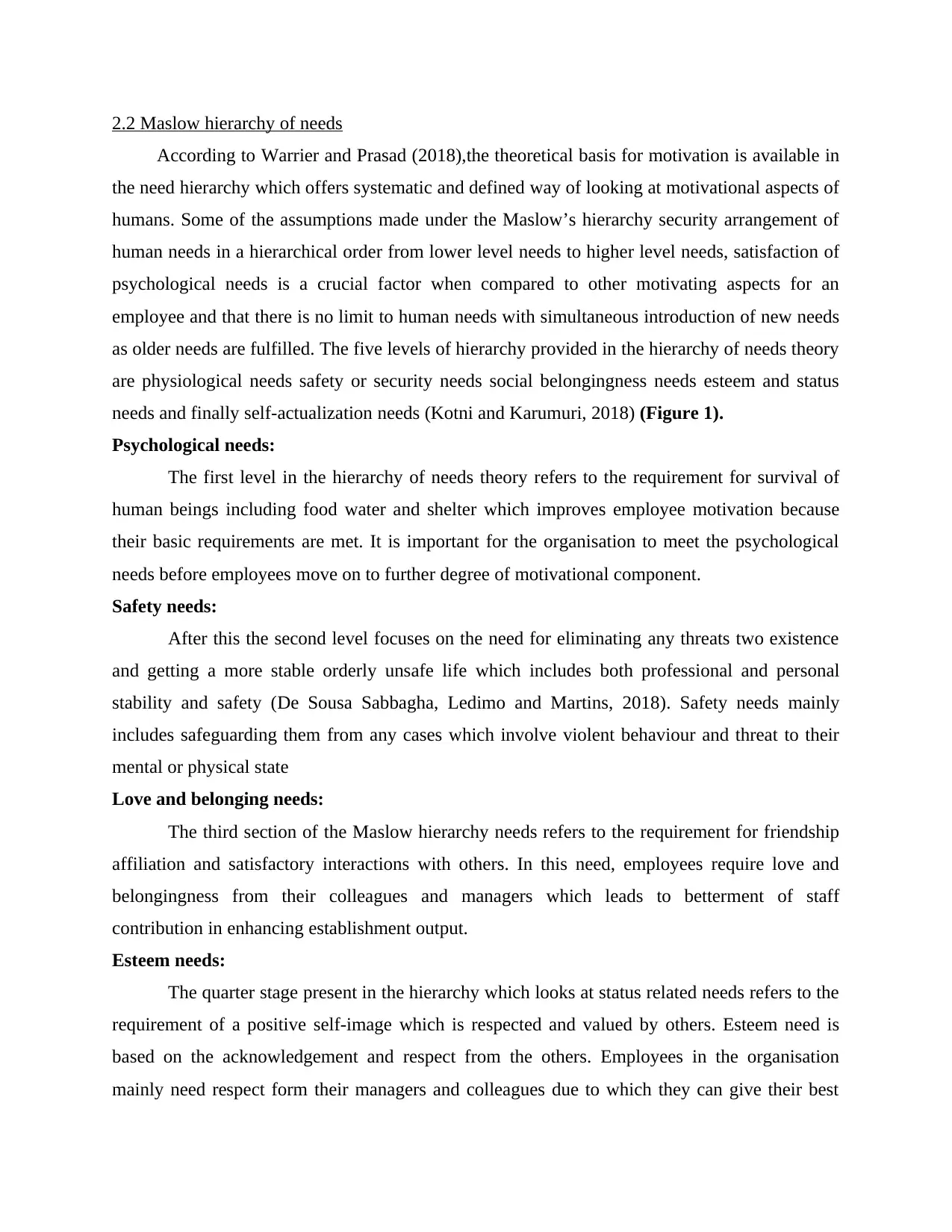
2.2 Maslow hierarchy of needs
According to Warrier and Prasad (2018),the theoretical basis for motivation is available in
the need hierarchy which offers systematic and defined way of looking at motivational aspects of
humans. Some of the assumptions made under the Maslow’s hierarchy security arrangement of
human needs in a hierarchical order from lower level needs to higher level needs, satisfaction of
psychological needs is a crucial factor when compared to other motivating aspects for an
employee and that there is no limit to human needs with simultaneous introduction of new needs
as older needs are fulfilled. The five levels of hierarchy provided in the hierarchy of needs theory
are physiological needs safety or security needs social belongingness needs esteem and status
needs and finally self-actualization needs (Kotni and Karumuri, 2018) (Figure 1).
Psychological needs:
The first level in the hierarchy of needs theory refers to the requirement for survival of
human beings including food water and shelter which improves employee motivation because
their basic requirements are met. It is important for the organisation to meet the psychological
needs before employees move on to further degree of motivational component.
Safety needs:
After this the second level focuses on the need for eliminating any threats two existence
and getting a more stable orderly unsafe life which includes both professional and personal
stability and safety (De Sousa Sabbagha, Ledimo and Martins, 2018). Safety needs mainly
includes safeguarding them from any cases which involve violent behaviour and threat to their
mental or physical state
Love and belonging needs:
The third section of the Maslow hierarchy needs refers to the requirement for friendship
affiliation and satisfactory interactions with others. In this need, employees require love and
belongingness from their colleagues and managers which leads to betterment of staff
contribution in enhancing establishment output.
Esteem needs:
The quarter stage present in the hierarchy which looks at status related needs refers to the
requirement of a positive self-image which is respected and valued by others. Esteem need is
based on the acknowledgement and respect from the others. Employees in the organisation
mainly need respect form their managers and colleagues due to which they can give their best
According to Warrier and Prasad (2018),the theoretical basis for motivation is available in
the need hierarchy which offers systematic and defined way of looking at motivational aspects of
humans. Some of the assumptions made under the Maslow’s hierarchy security arrangement of
human needs in a hierarchical order from lower level needs to higher level needs, satisfaction of
psychological needs is a crucial factor when compared to other motivating aspects for an
employee and that there is no limit to human needs with simultaneous introduction of new needs
as older needs are fulfilled. The five levels of hierarchy provided in the hierarchy of needs theory
are physiological needs safety or security needs social belongingness needs esteem and status
needs and finally self-actualization needs (Kotni and Karumuri, 2018) (Figure 1).
Psychological needs:
The first level in the hierarchy of needs theory refers to the requirement for survival of
human beings including food water and shelter which improves employee motivation because
their basic requirements are met. It is important for the organisation to meet the psychological
needs before employees move on to further degree of motivational component.
Safety needs:
After this the second level focuses on the need for eliminating any threats two existence
and getting a more stable orderly unsafe life which includes both professional and personal
stability and safety (De Sousa Sabbagha, Ledimo and Martins, 2018). Safety needs mainly
includes safeguarding them from any cases which involve violent behaviour and threat to their
mental or physical state
Love and belonging needs:
The third section of the Maslow hierarchy needs refers to the requirement for friendship
affiliation and satisfactory interactions with others. In this need, employees require love and
belongingness from their colleagues and managers which leads to betterment of staff
contribution in enhancing establishment output.
Esteem needs:
The quarter stage present in the hierarchy which looks at status related needs refers to the
requirement of a positive self-image which is respected and valued by others. Esteem need is
based on the acknowledgement and respect from the others. Employees in the organisation
mainly need respect form their managers and colleagues due to which they can give their best
⊘ This is a preview!⊘
Do you want full access?
Subscribe today to unlock all pages.

Trusted by 1+ million students worldwide
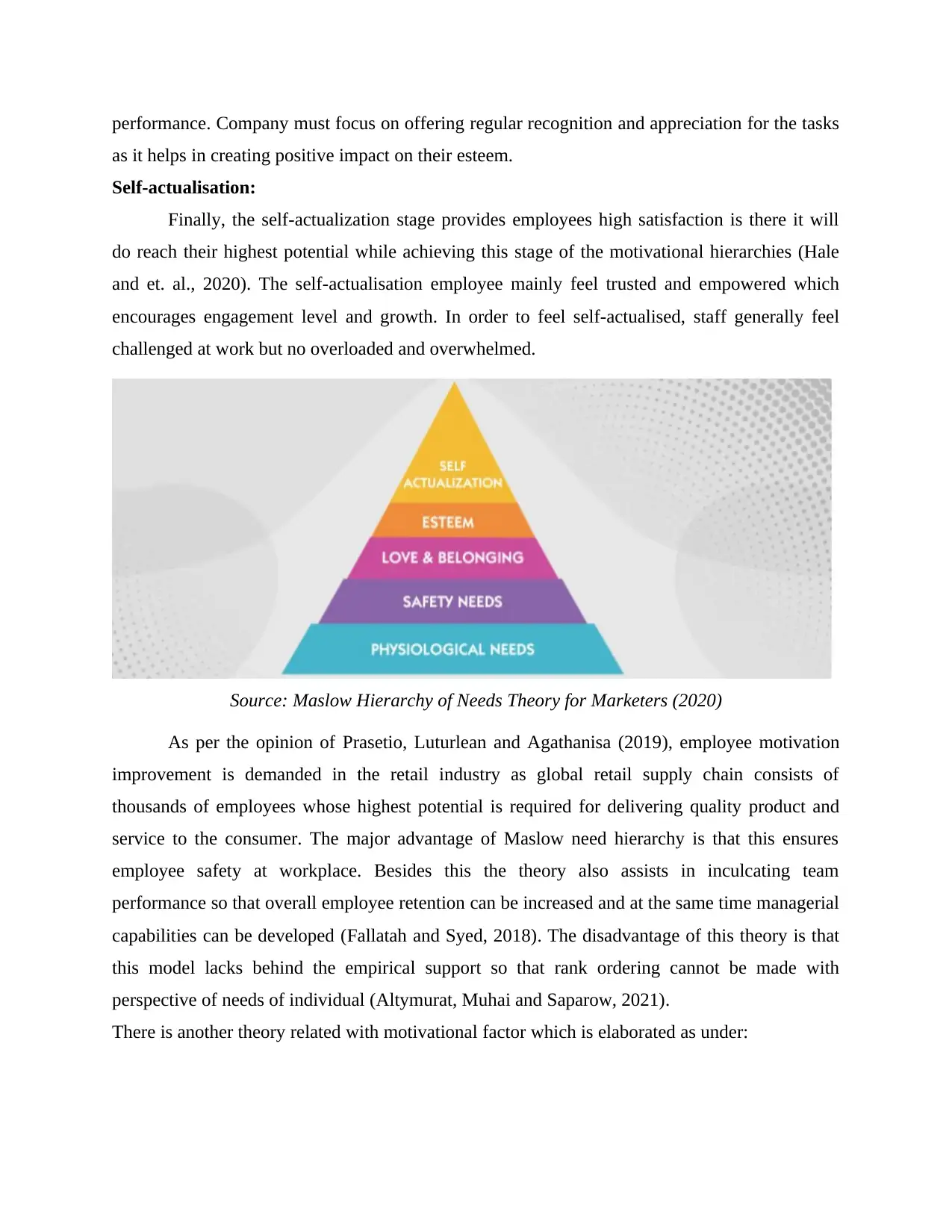
performance. Company must focus on offering regular recognition and appreciation for the tasks
as it helps in creating positive impact on their esteem.
Self-actualisation:
Finally, the self-actualization stage provides employees high satisfaction is there it will
do reach their highest potential while achieving this stage of the motivational hierarchies (Hale
and et. al., 2020). The self-actualisation employee mainly feel trusted and empowered which
encourages engagement level and growth. In order to feel self-actualised, staff generally feel
challenged at work but no overloaded and overwhelmed.
Source: Maslow Hierarchy of Needs Theory for Marketers (2020)
As per the opinion of Prasetio, Luturlean and Agathanisa (2019), employee motivation
improvement is demanded in the retail industry as global retail supply chain consists of
thousands of employees whose highest potential is required for delivering quality product and
service to the consumer. The major advantage of Maslow need hierarchy is that this ensures
employee safety at workplace. Besides this the theory also assists in inculcating team
performance so that overall employee retention can be increased and at the same time managerial
capabilities can be developed (Fallatah and Syed, 2018). The disadvantage of this theory is that
this model lacks behind the empirical support so that rank ordering cannot be made with
perspective of needs of individual (Altymurat, Muhai and Saparow, 2021).
There is another theory related with motivational factor which is elaborated as under:
as it helps in creating positive impact on their esteem.
Self-actualisation:
Finally, the self-actualization stage provides employees high satisfaction is there it will
do reach their highest potential while achieving this stage of the motivational hierarchies (Hale
and et. al., 2020). The self-actualisation employee mainly feel trusted and empowered which
encourages engagement level and growth. In order to feel self-actualised, staff generally feel
challenged at work but no overloaded and overwhelmed.
Source: Maslow Hierarchy of Needs Theory for Marketers (2020)
As per the opinion of Prasetio, Luturlean and Agathanisa (2019), employee motivation
improvement is demanded in the retail industry as global retail supply chain consists of
thousands of employees whose highest potential is required for delivering quality product and
service to the consumer. The major advantage of Maslow need hierarchy is that this ensures
employee safety at workplace. Besides this the theory also assists in inculcating team
performance so that overall employee retention can be increased and at the same time managerial
capabilities can be developed (Fallatah and Syed, 2018). The disadvantage of this theory is that
this model lacks behind the empirical support so that rank ordering cannot be made with
perspective of needs of individual (Altymurat, Muhai and Saparow, 2021).
There is another theory related with motivational factor which is elaborated as under:
Paraphrase This Document
Need a fresh take? Get an instant paraphrase of this document with our AI Paraphraser
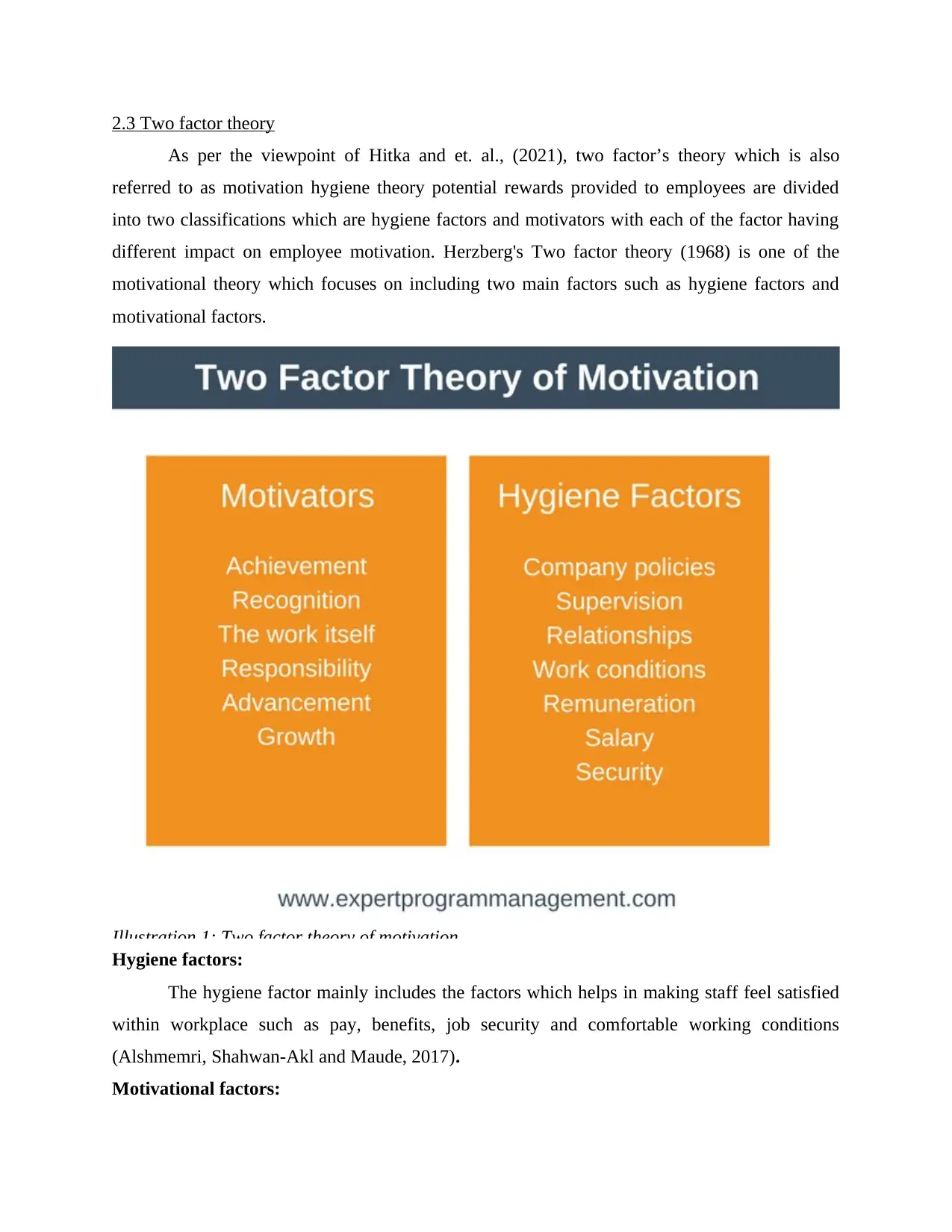
2.3 Two factor theory
As per the viewpoint of Hitka and et. al., (2021), two factor’s theory which is also
referred to as motivation hygiene theory potential rewards provided to employees are divided
into two classifications which are hygiene factors and motivators with each of the factor having
different impact on employee motivation. Herzberg's Two factor theory (1968) is one of the
motivational theory which focuses on including two main factors such as hygiene factors and
motivational factors.
Illustration 1: Two factor theory of motivation
Hygiene factors:
The hygiene factor mainly includes the factors which helps in making staff feel satisfied
within workplace such as pay, benefits, job security and comfortable working conditions
(Alshmemri, Shahwan-Akl and Maude, 2017).
Motivational factors:
As per the viewpoint of Hitka and et. al., (2021), two factor’s theory which is also
referred to as motivation hygiene theory potential rewards provided to employees are divided
into two classifications which are hygiene factors and motivators with each of the factor having
different impact on employee motivation. Herzberg's Two factor theory (1968) is one of the
motivational theory which focuses on including two main factors such as hygiene factors and
motivational factors.
Illustration 1: Two factor theory of motivation
Hygiene factors:
The hygiene factor mainly includes the factors which helps in making staff feel satisfied
within workplace such as pay, benefits, job security and comfortable working conditions
(Alshmemri, Shahwan-Akl and Maude, 2017).
Motivational factors:
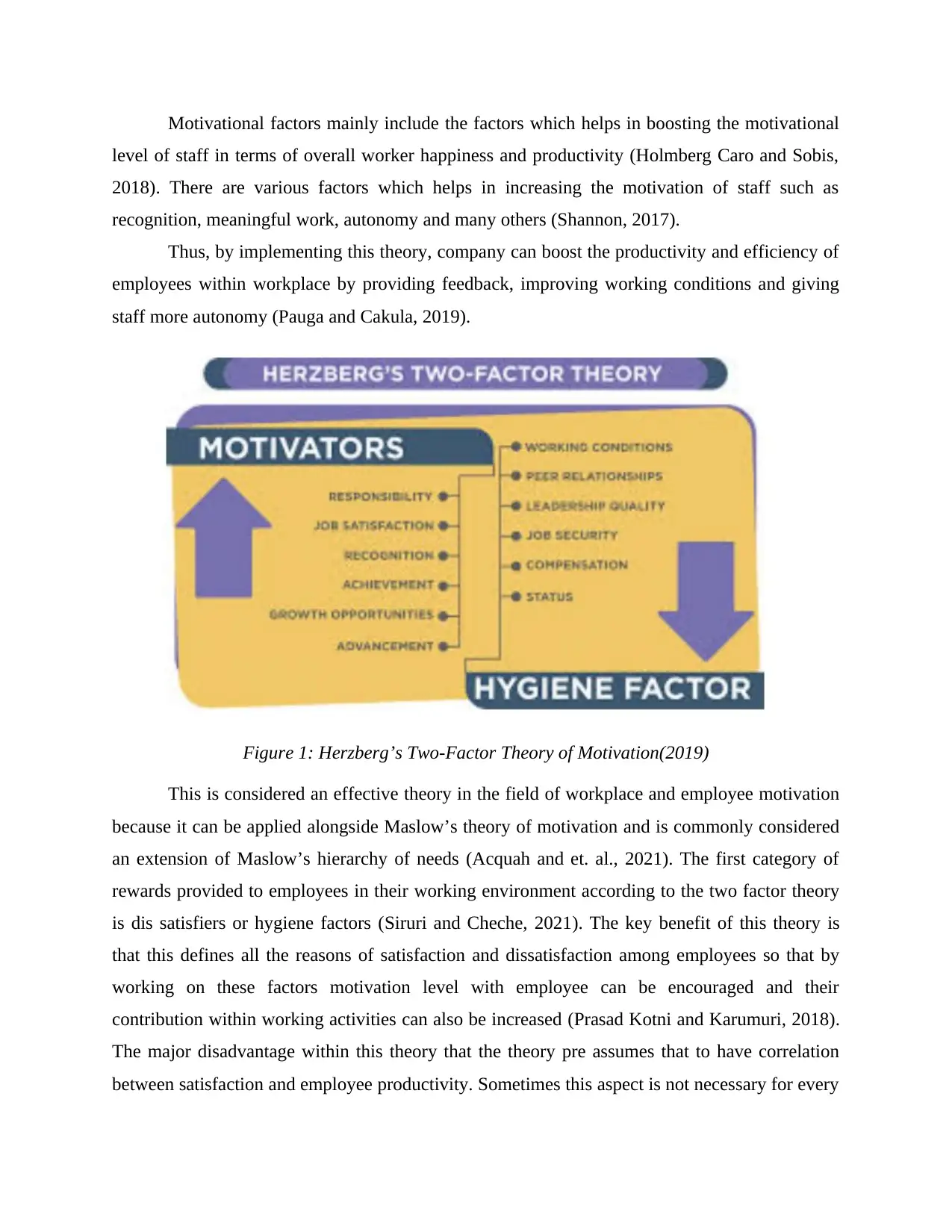
Motivational factors mainly include the factors which helps in boosting the motivational
level of staff in terms of overall worker happiness and productivity (Holmberg Caro and Sobis,
2018). There are various factors which helps in increasing the motivation of staff such as
recognition, meaningful work, autonomy and many others (Shannon, 2017).
Thus, by implementing this theory, company can boost the productivity and efficiency of
employees within workplace by providing feedback, improving working conditions and giving
staff more autonomy (Pauga and Cakula, 2019).
Figure 1: Herzberg’s Two-Factor Theory of Motivation(2019)
This is considered an effective theory in the field of workplace and employee motivation
because it can be applied alongside Maslow’s theory of motivation and is commonly considered
an extension of Maslow’s hierarchy of needs (Acquah and et. al., 2021). The first category of
rewards provided to employees in their working environment according to the two factor theory
is dis satisfiers or hygiene factors (Siruri and Cheche, 2021). The key benefit of this theory is
that this defines all the reasons of satisfaction and dissatisfaction among employees so that by
working on these factors motivation level with employee can be encouraged and their
contribution within working activities can also be increased (Prasad Kotni and Karumuri, 2018).
The major disadvantage within this theory that the theory pre assumes that to have correlation
between satisfaction and employee productivity. Sometimes this aspect is not necessary for every
level of staff in terms of overall worker happiness and productivity (Holmberg Caro and Sobis,
2018). There are various factors which helps in increasing the motivation of staff such as
recognition, meaningful work, autonomy and many others (Shannon, 2017).
Thus, by implementing this theory, company can boost the productivity and efficiency of
employees within workplace by providing feedback, improving working conditions and giving
staff more autonomy (Pauga and Cakula, 2019).
Figure 1: Herzberg’s Two-Factor Theory of Motivation(2019)
This is considered an effective theory in the field of workplace and employee motivation
because it can be applied alongside Maslow’s theory of motivation and is commonly considered
an extension of Maslow’s hierarchy of needs (Acquah and et. al., 2021). The first category of
rewards provided to employees in their working environment according to the two factor theory
is dis satisfiers or hygiene factors (Siruri and Cheche, 2021). The key benefit of this theory is
that this defines all the reasons of satisfaction and dissatisfaction among employees so that by
working on these factors motivation level with employee can be encouraged and their
contribution within working activities can also be increased (Prasad Kotni and Karumuri, 2018).
The major disadvantage within this theory that the theory pre assumes that to have correlation
between satisfaction and employee productivity. Sometimes this aspect is not necessary for every
⊘ This is a preview!⊘
Do you want full access?
Subscribe today to unlock all pages.

Trusted by 1+ million students worldwide
1 out of 59
Related Documents
Your All-in-One AI-Powered Toolkit for Academic Success.
+13062052269
info@desklib.com
Available 24*7 on WhatsApp / Email
![[object Object]](/_next/static/media/star-bottom.7253800d.svg)
Unlock your academic potential
Copyright © 2020–2025 A2Z Services. All Rights Reserved. Developed and managed by ZUCOL.





